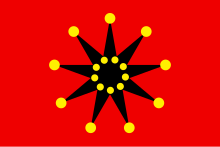Wuchang Uprising
| Wuchang Uprising | |
|---|---|
| Part of the | |
| Result |
Tongmenghui victory
|
| Wuchang Uprising | ||||||||||||||
|---|---|---|---|---|---|---|---|---|---|---|---|---|---|---|
Hanyu Pinyin | Wǔchāng Qǐyì | |||||||||||||
| ||||||||||||||
The Wuchang Uprising was an armed rebellion against the ruling
The uprising originated from popular unrest about a railway crisis, and the planning process took advantage of the situation.[2] On 10 October 1911, the New Army stationed in Wuchang launched an assault on the residence of the Viceroy of Huguang. The viceroy Ruicheng quickly fled from the residence, and the revolutionaries soon took control of the entire city.[3]
Background
Tongmenghui
In 1895, China was decisively defeated by Japan in the
Railway Protection Movement
After the
Meanwhile, inaction toward nationalization of railway lines in both Hunan and Hubei were criticized by the local press. Confidence in the Qing government among the populace continued to deteriorate in response to the escalation of the railway crisis.[10]
Uprising


Prelude
There were two revolutionary groups in the Wuhan area, the Literary Society (文學社) and the Progressive Association (共進會). These groups, led by Jiang Yiwu (蔣翊武) and Sun Wu (孫武) respectively, worked closely together as commander and chief of staff of the revolutionary efforts in Wuhan.
New Army mutiny
With their identities revealed, the revolutionaries in the New Army stationed in Wuchang were facing imminent arrest by the Qing authorities. The decision was made by Jiang Yiwu of the Literary Society to immediately launch the uprising, but the plot was leaked to the Viceroy of Huguang, and he ordered a crackdown of the revolutionaries, arresting and executing several prominent members.[13]
On the evening of 10 October, Wu Zhaolin (吴兆麟) as provisional commander led the revolutionary elements of the New Army staged a mutiny against the Qing garrison in Huguang, capturing the residence of the Viceroy in the process along with securing strategic points in the city after intense fighting.[13] As the Viceroy escaped, the Qing garrison fell into disarray. Between the night of 10 October and noon of 11th, "more than 500 Manchu soldiers were killed" with "over 300 captured".[14]
Establishment of Hubei military government
On 11 October, the mutineers established a military government representing the Hubei province, and persuaded one of the high-ranking officers in the New Army,
Battle of Yangxia

In response to the uprising, the Qing government called for the help of Yuan Shikai and the Beiyang Army to march toward Wuchang. For the revolutionaries, Huang Xing would arrive at Wuhan in early November to take over the command. Positions of revolutionary forces in Wuhan were subsequently attacked by the Beiyang Army, and the imperial troops were soon able to recapture Hankou on 1 November and Hanyang on 27 November. The offensive was halted after the capture of these two positions, as Yuan Shikai began to secretly negotiate with the revolutionaries.[16][17]
Aftermath

The Wuchang Uprising took many revolutionary leaders by surprise; Huang Xing and Song Jiaoren were unable to reach Wuchang in time.
As part of the resolution of the uprising, the Qing government agreed to a general amnesty for political prisoners.[20]: 44 Wang Jingwei was among those released.[20]: 44
In the same month, Sun returned to China to participate in the
References
Citations
- ^ Esherick & Wei 2013, p. 122.
- ^ a b Esherick & Wei 2013, p. 89.
- ^ Esherick & Wei 2013, p. 140–41.
- ^ Bergère & Lloyd 1998, p. 99.
- ^ Esherick & Wei 2013, p. 90.
- ^ Esherick & Wei 2013, p. 96.
- ^ Esherick & Wei 2013, p. 99.
- ^ Esherick & Wei 2013, p. 98.
- ISBN 978-1-4780-1121-7.
- ^ Esherick & Wei 2013, p. 13.
- ^ Esherick & Wei 2013, p. 140.
- ^ Esherick & Wei 2013, p. 165.
- ^ a b c d Esherick & Wei 2013, p. 107.
- ^ a b Esherick & Wei 2013, p. 141.
- ^ a b c Bergère & Lloyd 1998, p. 204.
- ^ a b Bergère & Lloyd 1998, p. 205.
- ^ Bergère & Lloyd 1998, p. 218.
- ^ a b Bergère & Lloyd 1998, p. 207.
- ^ Esherick & Wei 2013, p. 184.
- ^ ISBN 978-0-472-05650-7.
- ^ Bergère & Lloyd 1998, p. 208.
- ^ Bergère & Lloyd 1998, p. 209.
- ^ Bergère & Lloyd 1998, p. 219.
Sources
- Bergère, Marie-Claire; Lloyd, Janet (1998). Sun Yat-senb. Stanford: Stanford University Press. ISBN 978-0804740111.
- Esherick, Joseph W.; Wei, C.X. George (2013). China: How the Empire Fell. New York: Routledge. ISBN 978-1134612222.
- Cao, Yabo (1930). The Real History of Wuchang Uprising. Shanghai: Shanghai Bookstore Publishing House.
- CPPCC Hubei Committee (2011). Memoirs of the 1911 Revolution: Series 1. Wuhan: Hubei people's Publishing House. ISBN 9787503431050.
- Li, Yuanhong (1914). Vice President Li's Political Books. Vol. iii. Wuhan: Hubei Official Book Printing Bureau. ISBN 9787503431050.
- Lu, Hanchao (2017). Birth of a Republic. Seattle: University of Washington Press. ISBN 978-0295806907.
- "October 22nd". Republic of China Gazette. 22 October 1911.
- Yang, Yuru (2013). The First Book of the 1911 Revolution. Beijing: Intellectual Property Publishing House. ISBN 9787513016780.
- Zhang, Kaiyuan (1980). History of the 1911 Revolution (3). Beijing: Oriental Press. ISBN 9787547301234.
External links
 Media related to Wuchang Uprising at Wikimedia Commons
Media related to Wuchang Uprising at Wikimedia Commons
